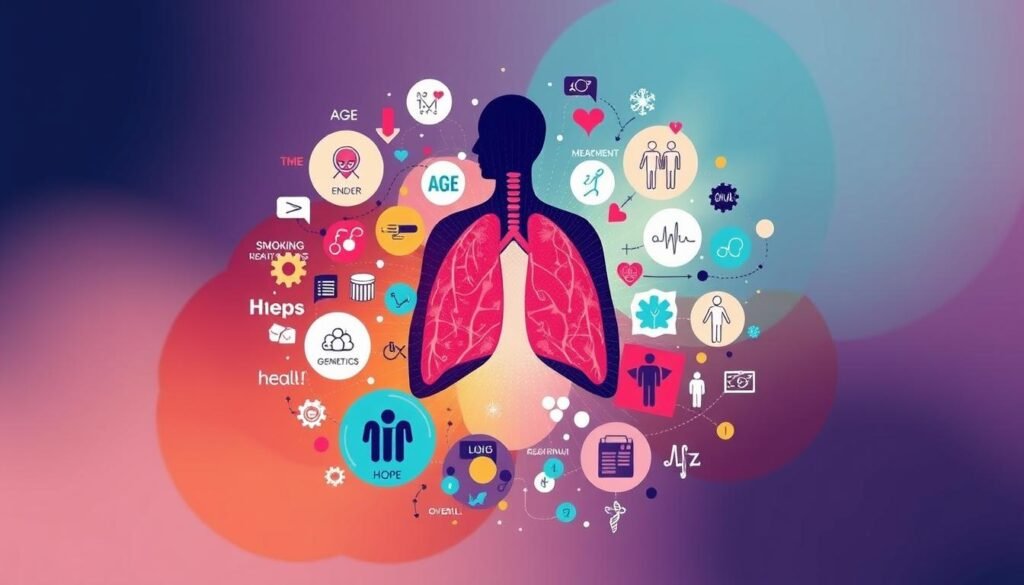About 65% of people with Stage 1 lung cancer live for five years or more. This shows that life expectancy varies greatly depending on the cancer stage. For those diagnosed with lung cancer, the news can be tough. They often hear they may live less than two years after being diagnosed. But there’s hope. Knowing more about lung cancer can help people find better outcomes.
The life expectancy for lung cancer depends on many things. These include the cancer type, treatment options, and overall health. While survival rates give us statistics, it’s important to remember they show results for groups, not individuals. Talking with doctors can help patients get a clearer picture of their situation. This allows them to make informed choices about their care.
Key Takeaways
- Stage 1 lung cancer has a 5-year survival rate of about 65%.
- Overall average life expectancy for patients diagnosed with lung cancer can be less than two years.
- Individual outcomes can vary significantly based on the stage and type of lung cancer.
- Conversations with healthcare professionals can provide more personalized prognoses.
- Understanding cancer survival rates is crucial for navigating treatment options.
Understanding Lung Cancer
Lung cancer mainly attacks the lungs due to uncontrolled cell growth. Many risk factors contribute to it, with smoking at the top. It’s also caused by secondhand smoke, environmental toxins like asbestos, and genetics.
To understand lung cancer, it’s important to know the early signs. These include a chronic cough, difficulty breathing, and losing weight without trying. Often, these early signs are missed, leading to late diagnosis and lower survival chances.
The following table summarizes some critical statistics regarding lung cancer and its impact:
| Statistic | Data |
|---|---|
| Median Survival Time (Elderly vs. Younger) | 37.8 weeks (Elderly), 57 weeks (Younger) |
| 1-Year Survival Rates | 42.5% (Elderly), 67.3% (Younger) |
| Response to Chemotherapy | Higher in Younger Patients |
| Anemia Incidence | Higher in Elderly Patients |
| Mortalities | Majority Among Elderly Patients |
| National Survival Rate Increase (Last 5 Years) | 26% to 28.4% |
| Screening Rate (Eligible Individuals) | 16.0% |
| Estimated Lives Saved by Screening | 80,000 Additional Years |
Lung cancer is the top cause of cancer deaths for men and women in the U.S. It’s a major public health issue. Knowing about it and catching it early can save lives. The fight against lung cancer includes understanding risks, spotting early symptoms, and getting help quickly.
Types of Lung Cancer
Lung cancers are mainly divided into two categories: Non-Small Cell Lung Cancer (NSCLC) and Small Cell Lung Cancer (SCLC). It’s important for patients, their families, and doctors to understand these types. They differ by how common they are, how fast they grow, and their survival rates.
Non-Small Cell Lung Cancer (NSCLC)
About 80–85% of lung cancers are NSCLC, making it the most common kind. It includes several subtypes like large cell carcinoma, squamous cell carcinoma, and bronchioloalveolar carcinoma (BAC). BAC patients can have a survival rate as high as 98% after surgery for less advanced cases.
For large cell lung cancer, the survival rate after five years is around 22.8%. Squamous cell lung cancer patients have a slightly higher survival rate of 25.2%. This shows how vital early detection and treatment tailored to each NSCLC subtype are.
Small Cell Lung Cancer (SCLC)
Small cell lung cancer represents about 10–15% of cases and is very aggressive. It has a very low five-year survival rate of only 8.6%, showing how quickly it can spread. How long a patient can live often depends on how early the cancer is found, underlining the importance of early detection.
SCLC is divided into limited and extensive stages, each affecting treatment options and chances of survival. Patients with this diagnosis usually need detailed treatment plans to improve their survival possibilities.
Life Expectancy with Lung Cancer
Lung cancer life expectancy varies a lot from person to person. It is affected by the cancer type, when it was found, and health. People with non-small cell lung cancer (NSCLC) often have a better outlook than those with small cell lung cancer (SCLC). Around 28% of NSCLC patients live at least five years after diagnosis. But, only about 7% of people with SCLC do the same.
Localized NSCLC has a five-year survival rate of 65%. But as cancer spreads, survival rates fall. For regional stages, the rate goes down to 37%. Distant stage diagnosis means only a 9% chance of living five more years. Small cell lung cancer shows even harsher numbers: 30% survival if local but just 3% if distant.
Lung cancer causes 25% of all cancer deaths. Sadly, advanced lung cancer often means living only a few months. However, younger individuals with less health problems generally fare better. Thus, regular screenings and catching the disease early are key to improving odds.
| Cancer Type | Localized Survival Rate | Regional Survival Rate | Distant Survival Rate | Overall 5-Year Survival Rate |
|---|---|---|---|---|
| NSCLC | 65% | 37% | 9% | 28% |
| SCLC | 30% | 18% | 3% | 7% |
Factors Influencing Survival Rates
Knowing what affects lung cancer survival can really help patients and their families. There are three big factors: lung cancer stage, type, and overall health. Each plays a big role in what to expect from treatment.
Stage of Lung Cancer
Finding out the stage of lung cancer early can make a big difference. People with lung cancer found at stages 0 or 1 have a better chance than those found at stages 2, 3, or 4. Sadly, many find out they have lung cancer when it’s already at stage IV, lowering their survival chances.
For small cell lung cancer patients, the five-year survival rate is 30% if found early. But, this drops sharply once the cancer spreads.
Type of Lung Cancer
The kind of lung cancer someone has also affects their survival chances. Non-Small Cell Lung Cancer (NSCLC) tends to have a brighter outlook than Small Cell Lung Cancer (SCLC). The five-year survival rate for NSCLC is about 28% across all stages.
On the other hand, SCLC’s five-year survival rate is only 3%. But, if caught early, 30% of SCLC patients can survive for five years or more.
Overall Health and Fitness
A patient’s general health matters a lot in fighting lung cancer. Those in good health might handle tough treatments better and have a better chance at living longer. It turns out, women and people who’ve never smoked often do better. This shows how important good health is when facing lung cancer.

| Factor | Impact on Survival Rates |
|---|---|
| Stage of Lung Cancer | Early stages (0 and 1) have better prognosis compared to late stages (2-4) |
| Type of Lung Cancer | NSCLC has a higher survival rate than SCLC |
| Overall Health | Better health increases the likelihood of enduring treatments and improving outcomes |
Cancer Survival Rates
Understanding cancer survival rates is important for people with lung cancer. These numbers help in making treatment choices and guessing future outcomes.
5-Year Relative Survival Rates
The national average 5-year survival rate for lung cancer is now 26.6%. This is a 22% increase from before. Those found with early-stage lung cancer have a bigger survival chance, about 61% make it past five years.
However, this rate drops to 7% for patients with cancer that has spread to distant parts. This shows why finding cancer early is so crucial.
Comparison by Stage
Looking at cancer stages shows big differences in survival rates. Sadly, only 26.6% of lung cancer is found early. Rhode Island has the best 5-year survival rates at 33.3%, while Oklahoma has the lowest at 21.2%.
This points out the importance of healthcare efforts and early screening in each state. Shockingly, only 4.5% of people who could be screened actually were in 2022.
For deeper insights on lung cancer survival rates and what affects these numbers, see WebMD’s detailed guide. Understanding these stats can help those affected by lung cancer make informed treatment choices.
Treatment Options for Lung Cancer
Lung cancer treatment uses different methods to fight the disease. Each method has its benefits depending on the cancer stage and the patient’s health. It’s important for patients to know about their treatment options. This knowledge helps them make good choices for their care.
Surgery and Its Impact on Survival
Surgery is a key method for treating lung cancer in its early stages. Depending on how far the cancer has spread, doctors might do different types of surgery. Surgery impact on survival is significant. Removing the tumor can stop the disease from spreading. Research supports that surgery can lead to better survival rates for many patients.
Chemotherapy and Lifespan Enhancement
Chemotherapy plays a big role in lung cancer treatment too. It’s often used after surgery to kill any cancer cells left behind. This can help patients live longer. Chemotherapy benefits include using a mix of drugs to stop cancer growth. Despite side effects like tiredness and feeling sick, many patients feel it’s worth it to fight the cancer.
Other Innovative Treatments
Other treatments are also making a difference in lung cancer care. Targeted therapies work on cancer cells with certain gene changes. Immunotherapy helps the immune system fight cancer, and is an option when surgery isn’t. Radiation therapy can be part of the plan too, either before or after surgery. These approaches improve how we treat lung cancer.
For more information on lung cancer treatments, visit the American Cancer Society.
| Treatment Type | Description | Survival Impact |
|---|---|---|
| Surgery | Removal of tumors and surrounding tissue | Significantly enhances survival rates |
| Chemotherapy | Combination of drugs to inhibit growth of cancer cells | Improves lifespan, especially post-surgery |
| Targeted Therapy | Focuses on specific genetic mutations | Provides tailored treatment options |
| Immunotherapy | Helps immune system identify and destroy cancer cells | Enhances body’s natural response to cancer |
The Role of Early Detection
Early detection of lung cancer dramatically improves treatment results and life span. Low-dose computed tomography (LDCT) scans help doctors find lung cancers early. This leads to much better survival chances. For example, patients found with stage IA cancer can have a 5-year survival rate over 90%. But for stage IV, the rate can fall under 10%.
It’s crucial to get screened for lung cancer regularly. Research shows that LDCT scans can lower the death rate by 20% compared to x-rays. However, knowing the risks is key since under 6% of those who should get screened actually do. Not enough people getting screened means missed chances for early finding and treatment.
Besides, it’s important to stay up-to-date with your health, risks, and when to get screened for lung cancer. Knowing how vital early detection is can inspire action in managing health care.
Palliative Care and Quality of Life
Palliative care boosts life quality for those fighting lung cancer. This care focuses on comfort and all-around support, aiming to ease disease symptoms and stress. No matter the cancer stage, teams of healthcare professionals like doctors, nurses, and social workers unite to offer a well-rounded care plan.
Understanding Palliative Care
Knowing what palliative care does is key for patients and their families. It’s not just for the final days; it’s helpful throughout the lung cancer battle. Studies show patients benefit from palliative care early on, managing their emotional, physical, and social challenges better.
The following table outlines the survival outcomes of patients based on the timing of palliative care intervention:
| Timing of Palliative Care | Adjusted Hazard Ratio (aHR) | Comments |
|---|---|---|
| 0 to 30 days after diagnosis | 2.13 | Worse survival outcomes compared to those not receiving care. |
| 31 to 365 days after diagnosis | 0.47 | Survival benefit observed. |
| Over 365 days after diagnosis | 1.00 | No significant difference in survival compared to non-receivers. |
| Facilities with high palliative care usage | 0.42 | Improved survival outcomes noted. |

Palliative care helps manage symptoms like pain, fatigue, and nausea. It also supports emotional well-being. Those with this care are less likely to need emergency services. Starting palliative care early is crucial. It ensures patients maintain dignity throughout their lung cancer journey by improving their overall life quality.
Emotional and Psychological Support for Patients
Emotional well-being is key for lung cancer patients during their treatment. The journey after a cancer diagnosis can be tough, leading to anxiety and stress. It’s very important for these patients to seek psychological support to build resilience and coping skills.
There are many programs aimed at supporting these patients. For instance, a six-session psychological program helped reduce depression and anxiety in 39 lung cancer patients. Also, a program involving walking at home lessened anxiety and depression, showing that physical activity aids emotional recovery.
Coping strategies are vital for managing emotional health. Techniques like deep breathing and progressive muscle relaxation can reduce anxiety. This is especially true for those who have trouble breathing. Healthy habits, such as getting enough sleep, eating right, and exercising, are also crucial for a stable mood and energy.
Talking to therapists who understand life-limiting illnesses can massively help. Lung cancer patients should also talk about their feelings with loved ones. Joining groups like the Lung Cancer Survivors Community on Inspire can be beneficial. It’s good to find activities that bring happiness and distraction.
Learning how to cope with lung cancer is necessary too. Asking about their health and treatment options makes patients feel in control. These support methods improve patients’ emotional health. They help patients see their journey in a more positive light, enhancing their quality of life.
| Intervention | Participants | Key Outcome |
|---|---|---|
| Exercise and Relaxation | 15 | Adherence rate of 76% |
| Psychosocial Support | 39 | Improvements in depression and anxiety |
| Cognitive-Behavioral Therapy | 25 | Reduced psychological distress |
| Psycho-Educational Intervention | 141 | Changes in symptom cluster |
| Home-Based Walking | 116 | Improved anxiety and depressive symptoms |
Living with Lung Cancer: Survivor Stories
Lung cancer survivor stories share deep insights into their lives. These stories highlight the courage and strength in the lung cancer community. They show how every journey is unique, but all stress the importance of quick diagnosis and treatment.
Ed’s story is a powerful example. He was diagnosed with stage 4 lung cancer after a screening showed a mass on his liver. Told he might only live 9 to 12 months without treatment, his life took a positive turn. Thanks to chemotherapy and immunotherapy trials, he was disease-free by April 2022. His story underlines the value of tailored treatments and the need for second opinions through biomarker testing.
People from all walks of life, including women and veterans, have shared their lung cancer journeys. They talk about overcoming treatment side effects and handling the emotional stress of cancer. Many were diagnosed while getting checked for something else, showing the need for more cancer symptom awareness.

Support networks play a key role in these stories. From family support to help from groups, these bonds bring hope. If you need help, the Lung Cancer Support Line at 844-835-4325 is there for you, offering advice and resources.
In the lung cancer community, there’s a big push for more awareness. These stories, from early to stage 4 cases, are filled with peace, thankfulness, and resolve. They highlight progress in treatments, including the newest FDA-approved drugs. For more on treatment options, check out this link.
Lung cancer survivor stories are more than personal victories. They are beacons of hope for others in similar battles. Sharing these stories keeps hope alive in the broader fight against lung cancer.
Conclusion
The journey with lung cancer is tough but there is hope. New treatments and understanding the disease better have changed patient outcomes. Yet, life expectancy for late-stage diagnoses is a serious concern. People can however manage their health better with good information.
A majority, 79%, of lung cancer cases are found in the later stages III and IV. Knowing factors like cancer stage, type, and health is key. This knowledge helps patients make better decisions with their doctors. Together, they work on treatments to live longer, better lives despite lung cancer.
Lung cancer care is getting better, giving patients hope for the future. It’s important for patients and families to talk openly about treatments and care. This ensures they face the challenge with the support and knowledge they need.